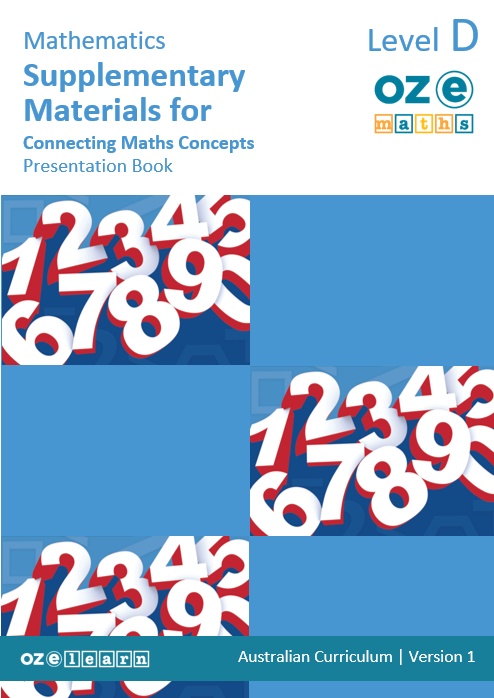Oz-e-maths Supplementary Materials for Connecting Maths Concepts Years F-5
Top-ups and Swap-outs for Currency and Measurement - Year 3
Write your awesome label here.
Write your awesome label here.

Teaching resources
Overview
Top-ups and Swap-outs for Currency and Measurement - Year 3 is a Mathematics unit for Year 3 students. It works in cooperation with Connecting Maths Concepts (CMC) to ensure that delivery of CMC aligns with Australian Curriculum gap requirements. It aligns to the Australian Curriculum:
- Use combinations of shapes and objects to make or approximate more complex shapes and objects in the environment (AC9M3SP01).
- Analyse the effectiveness of different displays or visualisations in illustrating and comparing data distributions, then discuss the shape of (AC9M3ST02).
- Represent money values in multiple ways and count the change required for simple transactions to the nearest five cents (ACMNA059).
- Measure, order and compare objects using familiar metric units of length, mass and capacity (ACMMG061).
- Tell time to the minute and investigate the relationship between units of time (ACMMG062).
Learning Objectives
- Define the terms: pyramid, polygon and net, and describe the process of using nets to construct three-dimensional shapes.
- Construct a triangular-based pyramid (tetrahedron).
- Define the term: prism and identify the net of a prism.
- Match 3D shapes to their net.
- Interpret picture graphs, bar graphs and line graphs.
- Compare data displayed as picture graphs, bar graphs and line graphs.
- Define symmetry and identify symmetry in the environment.
- Draw single and multiple lines of symmetry Identify symmetry in cave art and 2D shapes.
Success Criteria
- Define the terms: pyramid, polygon and net, and describe the process of using nets to construct three-dimensional shapes.
- Construct a triangular-based pyramid (tetrahedron).
- Define the term: prism and identify the net of a prism.
- Match 3D shapes to their net.
- Interpret picture graphs, bar graphs and line graphs.
- Compare data displayed as picture graphs, bar graphs and line graphs.
- Define symmetry and identify symmetry in the environment.
- Draw single and multiple lines of symmetry.
- Identify symmetry in cave art and 2D shapes.
Assessment
Mastery Tests
Cumulative Tests
- Mastery Tests are given at the end of every 10 lessons, designed to be taught over a two-week cycle. Mastery Tests allow teachers to monitor student understanding of the concepts taught in previous lessons and identify where reteaching is needed.
- The Teaching Guide contains the Mastery Test script. Mastery Tests are delivered using a presentation script, board displays and a handout for students. The Teaching Guide also contains the Answer Key.
Cumulative Tests
- There are two Cumulative Tests for Swap-Outs that are completed after lesson 60 and lesson 120. The Cumulative Tests are in the Teaching Guide.
- Teachers copy the assessment and distribute to students at testing time.
Recommended Units
Baninh Yeeum Building 302-310 Sheridan Street, Cairns QLD 4870
PO BOX 278, North Cairns QLD 4870
Phone: 1800 00 GGSA (4472)
info@goodtogreatschools.org.au
Empty space, drag to resize
Subscribe to our newsletter
Thank you!
Empty space, drag to resize
2023 All Rights Reserved
Write your awesome label here.
Write your awesome label here.
Write your awesome label here.
Subscribe to our newsletter now!
Get weekly updates on live streams, news and more right in your mailbox.
Thank you!
Write your awesome label here.
Write your awesome label here.
Planned 24 Hour Maintenance
Website Temporary Unavailable
10AM 05 January until 10AM 06 January 2024
Dear school teams
You will not be able to access your content during this time. We will be busy loading all the new enhancements you asked for. We are confident you will be delighted with the new features we have designed for you! Please join on Saturday after 10:00am to try them out!
School Partnerships Team

